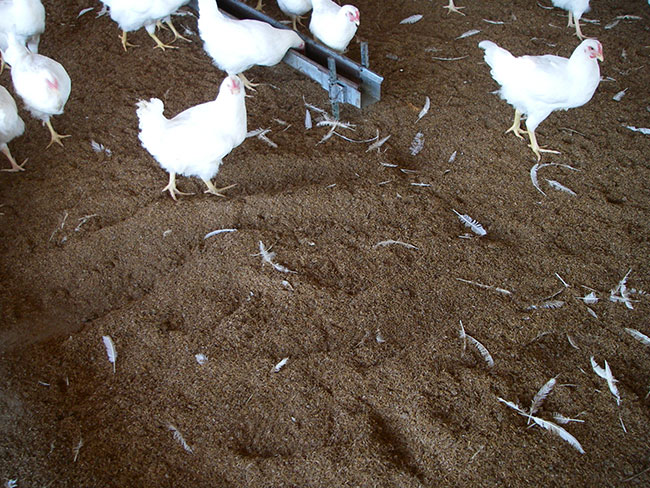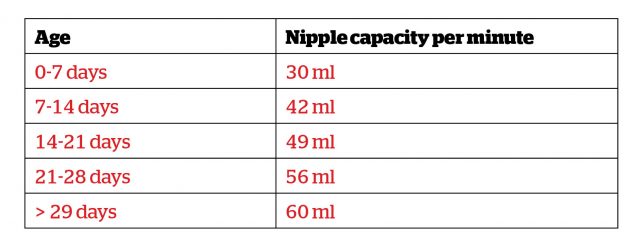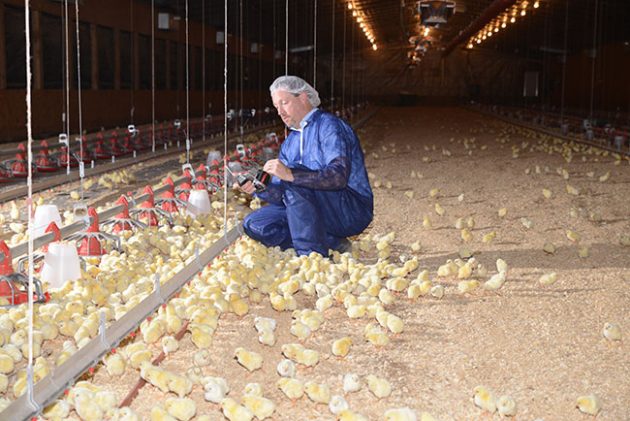
Leg health in pullets
By Benoit Lanthier
Features BreedersManagement strategies to prevent problems from developing in flocks.
 Correct ventilation will keep litter dry, which, in turn, will help reduce bacteria populations that can cause joint infections. PHOTO CREDIT: Cobb-Vantress
Correct ventilation will keep litter dry, which, in turn, will help reduce bacteria populations that can cause joint infections. PHOTO CREDIT: Cobb-Vantress Leg health, a hot topic in the poultry industry, can affect birds at various stages in their development and cause significant welfare and economic impacts. The best approach to leg health is to have a solid prevention program, since antibiotic interventions generally give poor results. The most common causes of leg issues are management-related. Basic management strategies can go a long way in preventing leg problems from developing in a pullet flock.
One of the main issues affecting pullets’ leg health is bacterial arthritis. It is caused by a bacterium, typically Staphylococcus aureus (Staph). Most commonly, Staph is an infection of the hock and other joints that causes inflammation, heat production and caseous exudate.
It’s worth noting, Staph is always present, even in healthy birds. However, stressing the birds will give the bacteria an opportunity to infect the articulations and may subsequently cause synovitis. Bacterial chondronecrosis with osteomyelitis (BCO) and femoral head necrosis (FHN) can also develop and the causes are similar to bacterial arthritis. The main focus should be on management to prevent bacterial-related leg issues.
Feed and nutrition
As synovitis usually develops during the maintenance period, it is important to make sure each pullet gets the needed feed allocation and nutrients each feeding day. To accomplish this, feed must be distributed in less than three minutes.
In addition, proper feed increases need to be given weekly to support growth. If the increases are insufficient, some pullets will not receive all the nutrients they need and the impact will be similar to poor feed distribution. When pullets are not getting their share of feed, they are more at risk to develop bacterial arthritis because they tend to eat litter which is the main source of the bacteria.
Enough feeder space is essential for each pullet to get their allotment of feed. Gradual increases in feeder space is ideal. At 12 weeks of age and after, we recommend six inches (15 cm) per pullet for chain feeders. For pan feeders, calculate the number of entrance points and subtract two to know how many pullets each pan feeder can accommodate.
As an example, an oval pan feeder with 16 holes can accommodate a maximum of 14 pullets.
Water quality
Water is the most important nutrient. Therefore, it is important that the flock receives the best quality water possible. The quality of the water can change over time. We recommend chemical and bacteriological analysis of the water on a regular basis. Take water samples from the source (tank, well, etc.) and at the end of the water line farthest from the source.
The warm temperature of the barn provides the perfect environment for biofilm (bacteria) to proliferate in the water lines. Even if the water source is clean, it could be full of bacteria by the time it gets to the birds. Therefore, always sample the water at the end of the water line to determine the water quality that the flock is drinking.
High bacterial loads in the water can be an important factor for the development of bacterial arthritis. To keep the water clean, acidify and chlorinate water continuously. The pH should range from six to 6.5 and free chlorine levels at the end of the water line range from three to five ppm. Remove chlorine (or any type of disinfectant or medication) 48 hours before administering vaccines through the water lines.
Enough water must be available based on the age of the birds. Never exceed eight to 10 birds per nipple and make sure the following flow rates are achieved:

Moisture control
Managing the environment can have a big impact on reducing the bacterial pressure on pullets. Wet litter is a significant source of bacteria and can lead to the development of bacterial arthritis. Work with your litter provider to make sure you always receive high quality dry litter material.
Also, make sure stocking density isn’t higher than recommended because it will be difficult to keep litter dry. High stocking density also leads to insufficient feeder space or water availability. Ensure that the water equipment is functioning adequately and that there aren’t any leaks.
Ventilation is the only way to remove moisture accumulation in a barn. Hens excrete, through feces and respiration, about 75 per cent of the water they consume. A flock of 10,000 pullets at 18 weeks will drink approximately 1,500 L (400 gallons) of water a day, and, in turn, 1,150 L (300 gallons) of moisture must be removed each day through ventilation. If ventilation is not optimal, that water will accumulate in the litter and cause a rise in ammonia concentrations and bacteria. With poor ventilation, the litter can become moist in a few days and, in less than two weeks, the litter can become wet.
Proper handling of the pullets
When vaccinating, moving or manipulating the pullets, always handle them with care. Handle the birds by both legs or by the wings. Handling the pullets by only one leg stresses the legs and joints and predisposes birds to bacterial synovitis. After rough handling, swelling of the joints can occur and have a major impact on pullet development.
The role of immunosuppression and infectious diseases
Some infectious diseases can predispose birds to developing septic arthritis. Immunosuppressive viruses such as IBD, CAV and Marek’s are good examples. A comprehensive vaccine program, proper biosecurity and solid management practices are essential to keep immunosuppressive diseases under control.
Some infectious diseases can also cause leg conditions. These include Mycoplasma synoviae (Ms) and chronic fowl cholera (Pasteurella multocida), which can cause septic arthritis. A complete biosecurity program can be very effective in preventing these diseases.
Tenosynovitis caused by reovirus can occasionally be an issue for pullets. However, reovirus is commonly found in healthy chickens. A diagnosis can only be made when lesions are identified by histology in the tendons and the virus is identified with lab diagnostics.
Prevention is accomplished mainly through a comprehensive vaccination program done at the grandparent level.
Good gut health will also help prevent bacterial joint infection. This can be achieved, in part, by controlling coccidiosis. When using a coccidiosis vaccine, always follow the guidelines from the manufacturer. For vaccination, keep the flock in a small enclosure to increase moisture in the litter, which is necessary for the life cycle of the vaccine’s oocysts. This increased density will make it easier for birds to be re-infected by the vaccine strains, a necessary step for the development of immunity.
When giving more space to the chicks, it is advisable to take litter from the brooding area and mix it with the new litter so birds can keep finding the oocysts and proper immunity is developed. Be cautious when using amprolium or any coccidia medications as they can greatly affect the development of coccidia immunity. In this case, birds may become susceptible to recurrent coccidia infection and necrotic enteritis.

Optimal brooding conditions can promote the health of the flock and reduce the risk of infections in the joints.
Incubation and brooding conditions
Good egg incubation conditions are important to reduce the incidence of leg conditions. Conditions such as angular deformities and increased infections with Staph can occur, especially if there is overheating during the egg incubation process.
Optimal brooding conditions are also a factor in controlling leg conditions. Follow the recommendations from our brooding guide (available at cobb-vantress.com). Chicks that are too hot or too cold may develop a range of conditions that will negatively impact performance and welfare.
Prevention
Prevention is the best solution to reduce leg problems. The following points must be considered when experiencing leg conditions:
- Brooding conditions
- Biosecurity and control of infectious diseases
- Coccidiosis control program
- Feed distribution
- Feeder space
- Water quality
- Moisture control and water quality
- Proper handling of pullets
Conclusions
There is no efficacious treatment for most leg conditions. Treatment with antibiotics may provide temporary relief but the condition tends to resurface some days or weeks after the treatment has ended. Prevention through good management practices is key to ensuring good leg health.
Benoit Lanthier is a technical services representative with Cobb-Vantress.
Print this page